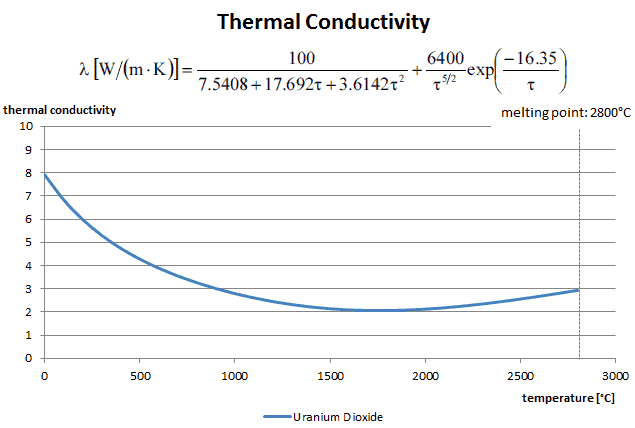Uranium dioxide is a ceramic refractory uranium compound, in many cases, used as a nuclear fuel. Most LWRs use uranium fuel in the form of uranium dioxide (chemically UO2). Uranium dioxide is a black semiconducting solid with very low thermal conductivity. On the other hand, uranium dioxide has a very high melting point and has well-known behavior.
Uranium dioxide has a significantly lower density than uranium in metal form. Uranium dioxide has a density of 10.97 g/cm3, but this value may vary with fuel burnup because, at low burnup, densification of pellets can occur, and at higher burnup, swelling occurs.
Thermal Conductivity of Uranium Dioxide
See also: Thermal Conduction of Uranium Dioxide
The thermal conductivity of uranium dioxide is very low when compared with metal uranium, uranium nitride, uranium carbide, and zirconium cladding material. Thermal conductivity is one of the parameters determining the fuel centerline temperature. This low thermal conductivity can result in localized overheating in the fuel centerline; therefore, this overheating must be avoided. Overheating of the fuel is prevented by maintaining the steady state peak linear heat rate (LHR) or the Heat Flux Hot Channel Factor – FQ(z) below the level at which fuel centerline melting occurs. Expansion of the fuel pellet upon centerline melting may cause the pellet to stress the cladding to the point of failure.
Thermal conductivity of solid UO2 with a density of 95% is estimated by the following correlation [Klimenko; Zorin]:
where τ = T/1000. The uncertainty of this correlation is +10% in the range from 298.15 to 2000 K and +20% in the range from 2000 to 3120 K.
Special reference: Thermal and Nuclear Power Plants/Handbook ed. by A.V. Klimenko and V.M. Zorin. MEI Press, 2003.
Special reference: Thermophysical Properties of Materials For Nuclear Engineering: A Tutorial and Collection of Data. IAEA-THPH, IAEA, Vienna, 2008. ISBN 978–92–0–106508–7.
Yellowcake – U3O8
Yellowcake, chemically U3O8, is a uranium concentrate powder recovered from leach solutions. Yellowcake is an intermediate step in the processing of uranium ores and nuclear fuel production. Typically, yellowcake can be obtained through the conventional milling and chemical processing of uranium ore forming a coarse powder. Yellowcake is a highly concentrated uranium powder; around 75% of the material is made up of uranium, or 750 kg of uranium oxide per tonne.
Before fuel fabrication, i.e., before conversion or enrichment, yellowcake is refined to obtain almost pure uranium in the form of triuranium octoxide (U3O8). Pure U3O8 is then used in the preparation of uranium fuel for nuclear reactors, for which triuranium octoxide powder may be sintered into fuel pellets (UO2) for use in fuel rods for pressurized heavy-water reactors. For other systems that use enriched uranium, uranium conversion and enrichment must follow this process.

